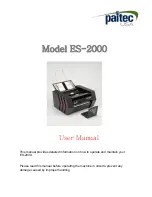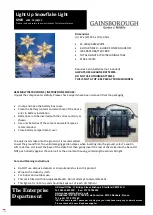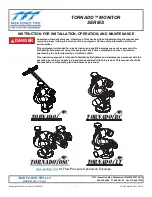
150.550UK User Manual
Installation
Read the safety information before installing the fixture.
The fixture is designed for indoor use only and must be used in a dry location with adequate ventilation. Ensure that
none of the fixture’s ventilation slots are blocked.
Fasten the fixture to a secure structure or surface. Do not stand it on a surface or leave it where it can be moved or fall
over. If you install the fixture in a location where it may cause injury or damage if it falls, secure it as directed in this user
manual using a securely anchored safety cable that will hold the fixture if the primary fastening method fails.
Fastening the fixture to a flat surface
The fixture can be fastened to a hard, fixed, flat surface that is oriented at any angle. Ensure that the surface and all
fasteners used can support at least 10 times the weight of all fixtures and equipment to be installed on it.
Fasten the fixture securely. Do not stand it on a surface or leave it where it can be moved or fall over. If you install the
fixture in a location where it may cause injury or damage if it falls, secure it as directed below with a securely anchored
safety cable that will hold the fixture if the primary fastening method fails.
Mounting the fixture on a truss.
The fixture can be clamped to a truss or similar rigging structure in any orientation. When installing the fixture hanging
vertically down, you can use an open-type clamp such as a G-clamp. When installing in any other orientation, you must
use a half-coupler clamp that completely encircles the truss chord.
To clamp the fixture to a truss:
1.
Check that the rigging structure can support at least 10 times the weight of all fixtures and equipment to be installed
on it.
2.
Block access under the work area.
3.
Fold the legs of the mounting bracket together and bolt a rigging clamp securely to the mounting bracket. The bolt
used must be M10, grade 8.8 steel minimum. It must pass through both mounting bracket legs and be fastened with
a self-locking nut.
4.
Working from a stable platform, hang the fixture with its clamp on the truss and fasten the clamp securely.
5.
Secure the fixture with a safety cable as directed below.
Securing with a safety cable
Secure the fixture with a safety cable (or other secondary attachment) that is approved for the weight of the fixture so
that the safety cable will hold the fixture if a primary attachment fails.
Loop the safety cable through the eyebolt in the back of the fixture and around a secure anchoring point. Do not loop the
safety cable around the fixture’s mounting bracket only, as this will leave the fixture unsecured if it separates from the
bracket.
DMX Connection
If you are using a suitable DMX controller to operate the Windmill you
can connect the DMX-output of the controller directly with the DMX-input
of the first fixture in the DMX-chain.
Building a serial DMX-chain
Connect the DMX-output of the first fixture in the DMX-chain with the DMX-input of the next fixture.
Always connect one output with the input of the next fixture until all fixtures are connected.
DMX-512 connection with DMX terminator
For installations where the DMX cable has to run a long distance or is in an electrically noisy environment, such as in a
club, it is recommended to use a DMX terminator. This helps in preventing corruption of the digital control signal by
electrical noise. The DMX terminator is simply an XLR plug with a 120 resistor connected between pins 2 and 3, which is
then plugged into the output XLR socket of the last fixture in the chain. (177.924UK recommended)


























